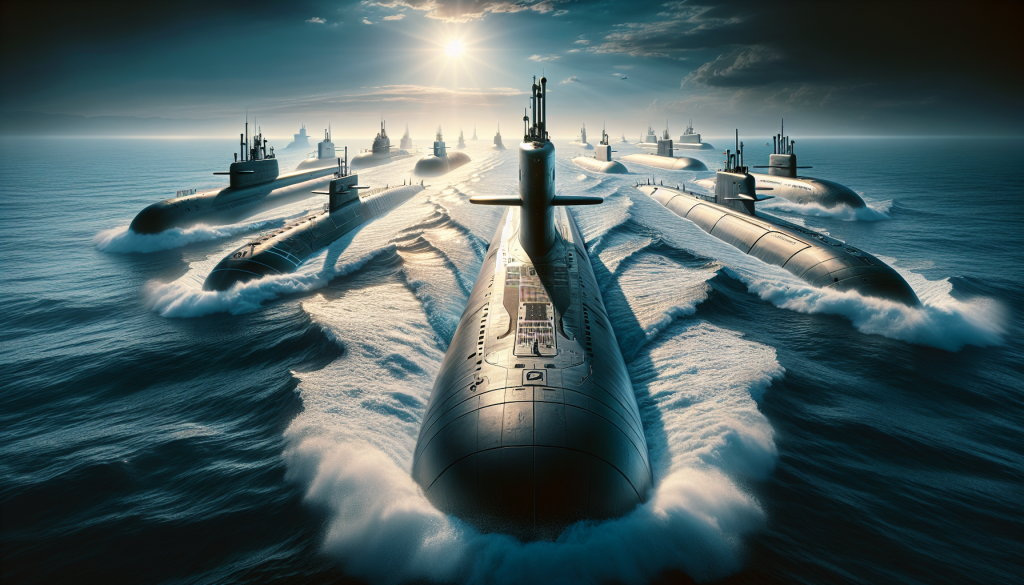In the vast expanses of the ocean, submarines represent the apex of underwater strategic might, a testament to a nation’s prowess in maritime warfare. As crucial assets of the Indian Navy, submarines of Indian Navy play a pivotal role in safeguarding our nation’s interests, offering us the ability to operate with stealth in enemy waters and strike with precision.
We understand the gravity these submerged guardians hold, capable of altering the dynamics of naval engagements and affirming India’s position as a formidable maritime power.

We take immense pride in the growth and capabilities of our submarine fleet, reflecting our commitment to defending our waters while ambitiously driving towards self-reliance in defense technologies. This article is dedicated to unveiling the expanse and might of the entire fleet of Indian Navy submarines, exploring the historical evolutions, and shedding light on the sophisticated Shishumar, Kalvari, and Arihant-class submarines.
As we steer through the waves of this discussion, we also anticipate the future trajectories of indigenous submarine development, echoing the aspirations of the Indian Navy’s Maritime Capability Perspective Plan.
Historical Evolution of Indian Submarine Fleet
The genesis of our submarine fleet, a cornerstone of the Indian Navy’s offensive and defensive strategies, can be traced back to the early 1960s. We embraced the strategic significance of submarines and initiated our journey with the acquisition of Foxtrot-class submarines from the Soviet Union. This pivotal move marked our foray into the realm of underwater warfare, laying the groundwork for future advancements.
- Early Acquisitions and Indigenous Developments:
- 1960s: Acquisition of Foxtrot-class submarines from the Soviet Union.
- 1990s: Commissioning of India’s first indigenous submarines, INS Shalki and INS Shankul, marking a significant leap towards self-reliance in submarine technology.
Our aspirations have always been to modernize and enhance our capabilities. The introduction of Scorpene-class submarines, also known as Kalvari-class, under the collaboration with France’s Naval Group, represents our enduring efforts to bolster our underwater warfare capabilities. The first of these advanced submarines was commissioned in 2017, with a total of six planned for induction by 2023.
- Modernization and Expansion:
- 2017: Commissioning of the first Scorpene-class submarine.
- By 2023: Induction of six Scorpene-class submarines, a testament to our commitment to fortifying our maritime security.
In our pursuit of a formidable and versatile fleet, we aim to acquire a mix of nuclear-powered attack submarines (SSNs) and nuclear-powered ballistic missile submarines (SSBNs). These acquisitions are pivotal in maintaining a strategic edge in the region. However, the path has not been without its challenges, including budget constraints and initial procurement delays due to reluctance from the USA and Britain.
- Challenges and Fleet Composition:
- Financial constraints and procurement challenges have historically impacted fleet expansion.
- Current Fleet: Operates one nuclear-powered submarine (Chakra), two nuclear-powered ballistic missile submarines (Arihant), and diesel-electric submarines across three classes – Kalvari, Shishumar, and Sindhughosh.
In our journey, we have bid farewell to 12 submarines, including 2 nuclear-powered and 10 diesel-electric, recognizing their service to our nation. As we continue to safeguard our waters, the submarines of the Indian Navy are not just vessels but embodiments of our naval aspirations and the guardians of our maritime sovereignty.
Shishumar-Class Submarines
We, the stewards of the Indian Navy’s underwater fleet, recognize the Shishumar-Class submarines as the vanguards of our diesel-electric attack capabilities. These formidable vessels, rooted in West German design, are the embodiment of our tactical acumen in the depths of the oceans. With four active units—INS Shishumar (S44), INS Shankush (S45), INS Shalki (S46), and INS Shankul (S47)—each submarine in India bears the mark of our commitment to maritime excellence.

- Design and Construction:
- Origin: West German HDW Type 209 design.
- Builders: Howaldtswerke-Deutsche Werft (HDW) and Mazagon Dock Limited (MDL).
- Commissioning: First two units in Germany, followed by two in India.
The Shishumar-Class, with a submerged displacement of 1,850 tons, stretches 64.4 meters in length and commands the seas with a 22-knot top speed when submerged. Our Indian submarine fleet prides itself on the Shishumar-Class’s endurance, boasting an 8,000 nautical mile range at a steady 8 knots, ensuring our presence is felt across vast maritime expanses.
- Specifications and Armament:
- Displacement: 1,450 tons (surfaced), 1,850 tons (submerged).
- Dimensions: Length – 64.4m, Beam – 6.5m, Draught – 6m.
- Propulsion: 4 × MTU diesel-electric motors, 1 × Siemens motor.
- Speed and Range: 22 knots (submerged), 8,000 nm at 8 knots.
- Armaments: Torpedoes, mines, and Harpoon missiles (on S46 and S47).
The Shishumar-Class has undergone a rigorous mid-life upgrade, enhancing their lethality and extending their service life by up to 15 years, a testament to our relentless pursuit of operational longevity and efficiency. This upgrade, a $151 million endeavor, includes the integration of the Boeing UGM-84L Harpoon Block II missiles on INS Shankush and INS Shalki, and a comprehensive modernization of combat and sensor systems by Atlas Elektronik.
- Mid-Life Upgrade:
- Budget: $151 million for system maintenance and new equipment.
- Upgrades: Harpoon missile systems and modernized combat systems.
- Extended Service: Operational life increased by 10-15 years.
Our Shishumar-Class submarines have demonstrated their prowess in various naval exercises, reinforcing their status as critical assets among India submarines. As we continue to strengthen our underwater fleet, these submarines remain at the forefront, safeguarding our waters and upholding the might of Indian Navy submarines.
Kalvari-Class Submarines
In the echelons of our underwater defense, the Kalvari-class submarines stand as a distinguished fleet within the Indian Navy submarines. As a testament to the Indo-French strategic partnership, these diesel-electric attack submarines, also known as Project-75, represent a significant stride in our maritime combat capabilities. The collaboration has yielded a formidable class of submarines—Vagir, Kalvari, Khanderi, Karanj, Vela, and Vagsheer—each named with a resonant heritage and purpose.

- Design Excellence and Specifications:
- Origin: French Scorpène-class design by Naval Group.
- Dimensions: Length – 220 feet, Height – 40 feet.
- Speed: 11 knots surfaced, 20 knots submerged.
- Endurance: Approximately 50 days, showcasing remarkable operational sustainability.
Our submarine in India, the Kalvari-class, is equipped with cutting-edge surveillance and intelligence-gathering systems, enhancing our tactical prowess. These submarines, with their sleek dimensions, are engineered for stealth and agility, capable of launching an array of torpedoes and missiles.
- Armament and Capabilities:
- Torpedo Tubes: Six 533 mm tubes.
- Weaponry: A combination of 18 SUT torpedoes and SM39 Exocet missiles or 30 mines.
- Crew: 8 officers and 35 sailors, a testament to our disciplined and skilled naval personnel.
With INS Kalvari (S21) commissioned in 2017 and the recent induction of INS Vagir (S25) in 2023, these submarines of the Indian Navy have bolstered our maritime security, reflecting India’s commitment to a secure and self-reliant defense framework. The Kalvari-class is not just a fleet but a symbol of our naval ambition and the guardians of our nation’s maritime sovereignty.
Arihant-Class Submarines
In the realm of strategic deterrence, our Arihant-Class submarines ballistic missile submarines stand as the pillars of India’s underwater nuclear capability. These indigenously built SSBNs are a crowning achievement of the Indian Navy, symbolizing our unwavering commitment to national security and technological prowess.

- Indigenous Development and Strategic Might:
- The Advanced Technology Vessel (ATV) project, a cornerstone of our defense innovation, has successfully birthed the Arihant-Class, with INS Arihant commissioned in 2016, marking a new era for submarines of Indian Navy.
- Our submarine in India, specifically the Arihant-Class, is a series of five planned boats, meticulously constructed at the Ship Building Center, Visakhapatnam, a testament to our self-reliance in defense technologies.
- Enhanced Capabilities and Armaments:
- Each submarine in this class is a fortress of might, armed with K-15 Sagarika missiles and the more formidable K-4 missiles, with ranges of 750 km and 3,500 km respectively, fortifying our second-strike capabilities.
- The third vessel, S4, surpasses its predecessors in size and strength, capable of housing eight K-4 or 24 K-15 SLBMs, a significant leap in our maritime deterrent force.
- Fleet Expansion and Future Outlook:
- Presently, the Indian submarine fleet includes two operational SSBNs, INS Arihant and INS Arighat, with a displacement of 6,000 tonnes each.
- In the pipeline, we have the S4 and the S4 ‘star’, each surpassing the Arihant-class by over 1,000 tonnes, with expected launches by 2020 and 2022, solidifying the formidable stature of indian navy submarines.
Our Arihant-Class submarines are not merely vessels; they are the guardians of our nation’s second-strike capability, ensuring that our nuclear deterrent remains invincible in the face of adversity. As we continue to expand our underwater fleet, these submarines of Indian Navy stand as unwavering sentinels of peace and stability in the region.
Future Developments and Acquisitions
As we look toward the horizon, our Indian Navy submarines are set for a transformative journey with Project 75I, a pivotal initiative aimed at augmenting our underwater combat capabilities. This ambitious project underscores our commitment to fortify the submarines of the Indian Navy with six cutting-edge submarines, each equipped with advanced diesel-electric propulsion and pioneering air-independent propulsion (AIP) systems, which promise to significantly enhance underwater endurance and stealth.

- Project 75I Highlights:
- Acquisition of six advanced submarines with diesel-electric and AIP systems.
- Emphasis on greater underwater endurance and stealth capabilities.
Our aspirations for a formidable submarine in India have drawn the attention of international contenders, with Germany’s ThyssenKrupp Marine Systems and Spain’s Navantia emerging as potential partners in this strategic endeavor. Spain, in particular, has made a compelling case by offering full technology transfer and the most competitive pricing for the $5-billion deal, positioning them as a strong frontrunner.
- International Collaboration Prospects:
- Germany and Spain as potential partners for Project 75I.
- Spain’s offer includes full technology transfer and the lowest bid.
Navantia’s proposed S-80 submarines, boasting a displacement of 3,000 tonnes and a proven AIP system, are set to be manufactured in India, in line with the Make in India program, through a teaming agreement with Larsen & Toubro (L&T). This partnership not only elevates our indigenous manufacturing capabilities but also aligns with our strategic vision of self-reliance in defense.
- Make in India Initiative:
- Navantia’s S-80 submarines to be manufactured in India.
- Collaboration with L&T reflects our push for self-reliance in defense manufacturing.
Our roadmap for the Indian Navy’s maritime might extends beyond submarines, encompassing the acquisition of eight next-generation corvettes, nine additional submarines, five survey vessels, and two multi-purpose vessels. Despite the challenges posed by delays in Project-75-India, our resolve remains unwavering. The planned construction of a third aircraft carrier, seven 6,670-tonne stealth frigates under Project-17A, and the procurement of 12 Sukhoi-30 MKI fighter jets, collectively valued at Rs 45,000 crore, are monumental steps in our defense strategy. Furthermore, the completion of Project Varsha’s first phase by 2022 will see our SSBN fleet securely housed at Rambilli. Our vision encapsulates the acquisition of 10 nuclear submarines and 9 diesel-electric submarines, ensuring that India submarines continue to be a potent force in safeguarding our nation’s maritime sovereignty.
Conclusion
The evolution and advancements of the Indian Navy’s submarine fleet, as discussed, are a testament to India’s strategic foresight and determination to secure its maritime boundaries. Our exploration through the historical development, capabilities, and future projects of vessels like the Shishumar, Kalvari, and Arihant-class submarines reflects a clear trajectory towards a robust underwater warfare force. This commitment to indigenous development and strategic partnerships underscores the Navy’s dedication to maintaining sovereignty and peace in the region.
Looking ahead, the drive for self-reliance and modernization continues to shape the Indian Navy’s submarine program. The emphasis on Project 75I and international collaborations signals a future where technological excellence and enhanced capabilities will fortify our maritime defense. These vessels are not just components of naval power, but guardians of our blue waters, integral to India’s defense narrative and its stature on the global maritime stage.
FAQs
1. How many submarines does the Indian Navy currently have?
The Indian Navy’s fleet includes two nuclear-powered ballistic missile submarines, 16 conventionally powered attack submarines.
2. Can you explain what Project 75 is?
Project 75 is a key submarine procurement initiative of the Indian Navy, focusing on the design and construction of six advanced Scorpene-class conventional submarines.
3. What is the largest submarine in the Indian Navy’s arsenal?
The largest submarine in the Indian Navy’s arsenal is the INS Arihant, which belongs to the Arihant class of ballistic missile submarines (SSBNs).
4. What is the latest addition to the Indian Navy’s submarine fleet?
The latest addition to the Indian Navy’s submarine fleet is the INS Vagsheer, the sixth and final Kalvari-class Scorpene submarine. This submarine was built under Project 75 and is set to be delivered in March 2024.













